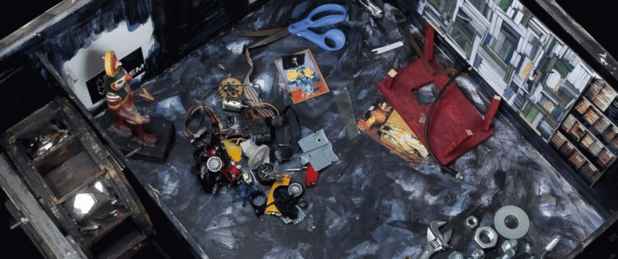“Memories of Utopia: Jean-Luc Godard’s ‘Collages de France’ Models” Exhibition
Miguel Abreu Gallery

This event has ended.
Organized by Miguel Abreu and Aurélien Poitrimoult
This exhibition is dedicated to the memory of Dan Talbot.
As Nathan Lee wrote in his 2006 New York Times review, “the Georges Pompidou Center [Paris] began a retrospective devoted to a man synonymous with cinema itself: Jean-Luc Godard.” Now 87, the consummate filmmaker has been transforming motion pictures for over 60 years. From his 1955 documentary, Operátion Béton, to his latest still unfinished work, Le Livre d’Image, Godard has tirelessly experimented with images, sounds, and language, and is regarded as one of the greatest visual intelligences at work and one of the most significant artists of our times.
“For the Godard cult,” Lee continued, “the Pompidou Center exhibition is epochal; the mother ship of mise-en-scène has landed. The full film retrospective, however, was “only foreplay to the main seduction. Travel(s) in Utopia, Jean-Luc Godard 1946 – 2006, In Search of a Lost Theorem, is the unwieldy title of an unruly installation that sprawls throughout the large south gallery of the museum. Designed and executed by Godard, the show opened amid much controversy.” Indeed, rumor had it before the opening “that relations between the artist and the museum had soured,” noted Lee, “and that the project would not be realized. The nature of what, if anything, would take its place remained an enigma until the moment of its unveiling.”
The intended exhibition was “to have been called Collage(s) de France,” Lee pointed out, “and to have functioned as a kind of elaborate, three-dimensional montage of Godard’s methods and motifs. The visitor would proceed through a series of thematic rooms. ‘Myth’ would give way to ‘Humanity’ and ‘The Camera,’ pass through ‘The Unconscious’ and end with ‘Murder’ and ‘The Tomb.’ Giant reproductions of paintings (by Delacroix, Goya, Nicolas de Staël) would adorn the walls alongside printed quotations and blown-up movie stills. Films and videos would flicker on televisions, screens and even a video iPod. Sculptural and environmental objects would allude to Freud, the Middle East and cinematic technologies. Collage(s) de France was to have carried the subtitle ‘Archaeology of the Cinema,’ an apt phrase given that all that remains of this fabled creature are its bones. Detailed scale models of the original conception are scattered throughout Travel(s) an exhibition about an exhibition — and thus quintessential Godard.”
The eighteen maquettes produced by Godard between 2003 and 2005 for Collages de France, are exhibited here for the first time since their initial presentation at the Pompidou Center. Meticulously designed dollhouse-like rooms buzzing with electric motors and small lights, “they are the depositary,” says Lee, “the sketch, the graveyard of Godard’s original conception, the score of a symphony forever unperformed.”
In Godard, le dos au musée – histoire d’une exposition, Anne Marquez’s monumental study on the evolution of the exhibition, she argues that “the maquette remains the most important element to have survived Godard’s great museographical experiment. […] It is to Collages de France a little as Tatlin’s Tower is to his Monument to the 3rd International, designed to be realized in iron and glass, but existing only in the form of a wooden maquette: miniaturizations of a political or artistic utopia of which they remain the emblem. The ultimate fate of these ‘works of the spirit,’ however, was contrary to the properly artistic dimension that should be their defining characteristic.”
At 36 Orchard Street, along with the presentation of documents pertaining to the models at hand, publications on Godard and his work and DVDs of select films, Souvenir d’Utopie, a short video by Anne-Marie Miéville is on view on a monitor along with Godard film excerpts. In this work the maquettes are filmed with tight, static shots, without commentary, punctuated with cuts to black. The montage is abrupt and rapid, and features only fixed images. The film records a realized miniaturized proposition and unfolds in a time and space that is now gone, at once a regretful look back at Collages de France (memory) and a reference to what became the exhibition (utopia). “The video as a whole,” Marquez notes, “is an almost abstract visit to a Collages de France without scale, a fictional walk through an exhibition that one could almost believe had actually taken place.”
Media
Schedule
from January 14, 2018 to February 25, 2018
Opening Reception on 2018-01-14 from 18:00 to 20:00